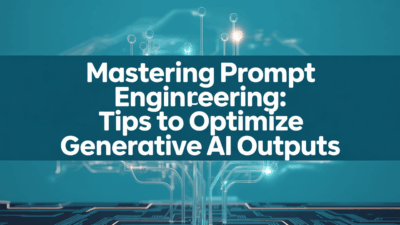Generative AI has rapidly become a cornerstone of modern technology, influencing everything from content creation to software development. As businesses and developers seek to harness the power of artificial intelligence, selecting the right generative AI platform is crucial. This article provides a detailed comparison of the top generative AI platforms based on their features, pricing models, and use cases.
Key Features of Generative AI Platforms
Before diving into specific platforms, it’s important to understand what features are commonly offered by these tools. Generative AI platforms typically provide capabilities such as data generation and augmentation, natural language processing (NLP), and image and video creation . These functionalities allow users to automate tasks, enhance creativity, and improve productivity across various domains.
Top Generative AI Platforms
ZBrain
ZBrain stands out as a generative AI platform tailored specifically for IT applications . It offers robust NLP capabilities and integrates seamlessly with existing IT infrastructures, making it ideal for organizations looking to streamline their operations through automation.
LeewayHertz
LeewayHertz provides customizable solutions that cater to diverse industry needs. Its platform supports both text and image generation, offering flexibility for creative projects and enterprise-level applications alike.
Markovate
Markovate excels in delivering end-to-end AI solutions, including advanced chatbot development and content generation tools. The platform’s strength lies in its ability to handle complex datasets efficiently, enabling high-quality output even under demanding conditions.
H2O.ai
H2O.ai focuses on democratizing machine learning and AI. With strong support for data scientists, this platform facilitates rapid model deployment and scalable analytics, which can be leveraged for generating insights and predictive modeling.
OpenAI
OpenAI remains one of the most recognized names in generative AI, known primarily for its GPT series of models. Tools like ChatGPT and GPT-4 offer powerful text generation capabilities, while DALL-E enables users to create images from textual descriptions . GitHub Copilot, powered by OpenAI Codex, assists developers with code suggestions, enhancing coding efficiency significantly .
IBM Watson
IBM Watson brings enterprise-grade AI solutions to the table. Its suite includes tools for conversational AI, visual recognition, and speech-to-text conversion, among others. Watson’s integration with cloud services makes it suitable for large-scale deployments.
Microsoft Azure AI
Microsoft Azure AI offers comprehensive AI services within the broader Azure ecosystem. Features include cognitive services for vision, speech, and language understanding, along with pre-built APIs for common AI tasks. Integration with Microsoft products ensures smooth workflow adoption for enterprises already using Windows or Office 365.
Google Vertex AI
Google Vertex AI provides a unified interface for building and deploying ML models at scale. It supports multiple frameworks and languages, allowing developers to choose the best tools for their project requirements. Additionally, Google’s Vertex AI incorporates AutoML capabilities, simplifying the process of creating custom models without extensive expertise.
Pricing Considerations
When evaluating generative AI platforms, cost plays a significant role. For instance, OpenAI charges $0.12 per thousand tokens for output, whereas input costs for GPT-3.5 Turbo with 4k context are priced at $0.0015 per thousand tokens . Similarly, other providers may have different pricing structures depending on usage metrics, subscription plans, or pay-as-you-go options. Organizations should carefully assess their budget constraints and expected utilization before committing to any service.
Use Cases Across Industries
The versatility of generative AI platforms allows them to address a wide array of challenges across industries:
- Content Creation: Platforms like Artbreeder and RunwayML enable artists and designers to generate unique visuals quickly.
- Software Development: Tools such as GitHub Copilot assist developers in writing code more efficiently, reducing time spent debugging and increasing overall productivity.
- Customer Service Automation: Chatbots developed via platforms like IBM Watson or Microsoft Azure AI help companies deliver personalized customer experiences around the clock.
- Data Analysis & Insights Generation: By leveraging NLP techniques, businesses can extract valuable insights from unstructured data sources, aiding decision-making processes.
In conclusion, choosing the right generative AI platform depends heavily on your specific needs—whether you’re aiming to boost developer efficiency, automate customer interactions, or innovate in digital media production. Each platform reviewed here offers distinct advantages; therefore, aligning your choice with strategic goals will ensure optimal outcomes. As the landscape continues evolving rapidly, staying updated about new developments and enhancements becomes essential for maintaining competitive edge.
